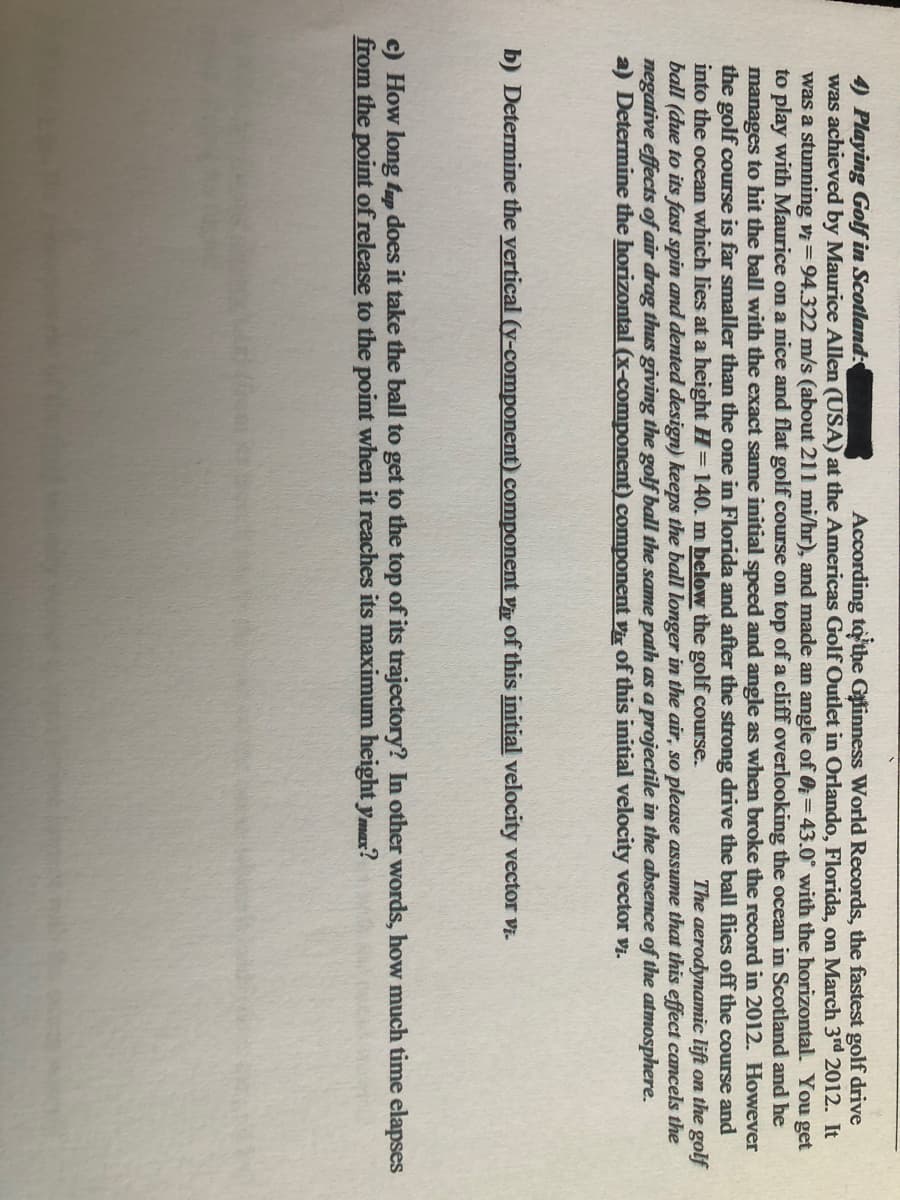4) Playing Golf in Scotland: was achieved by Maurice Allen (USA) at the Americas Golf Outlet in Orlando, Florida, on March 3rd 2012. It was a stunning v= 94.322 m/s (about 211 mi/hr), and made an angle of O= 43.0° with the horizontal. You get to play with Maurice on a nice and flat golf course on top of a cliff overlooking the ocean in Scotland and he manages to hit the ball with the exact same initial speed and angle as when broke the record in 2012. However the golf course is far smaller than the one in Florida and after the strong drive the ball flies off the course and into the ocean which lies at a height H=140. m below the golf course. ball (due to its fast spin and dented design) keeps the ball longer in the air, so please assume that this effect cancels the negative effects of air drag thus giving the golf ball the same path as a projectile in the absence of the atmosphere. a) Determine the horizontal (x-component) component vix of this initial velocity vector vi. According to the Glinness World Records, the fastest golf drive The aerodynamic lift on the golf b) Determine the vertical (y-component) component vi of this initial velocity vector vi. c) How long tup does it take the ball to get to the top of its trajectory? In other words, how much time elapses from the point of release to the point when it reaches its maximum height ymax?
4) Playing Golf in Scotland: was achieved by Maurice Allen (USA) at the Americas Golf Outlet in Orlando, Florida, on March 3rd 2012. It was a stunning v= 94.322 m/s (about 211 mi/hr), and made an angle of O= 43.0° with the horizontal. You get to play with Maurice on a nice and flat golf course on top of a cliff overlooking the ocean in Scotland and he manages to hit the ball with the exact same initial speed and angle as when broke the record in 2012. However the golf course is far smaller than the one in Florida and after the strong drive the ball flies off the course and into the ocean which lies at a height H=140. m below the golf course. ball (due to its fast spin and dented design) keeps the ball longer in the air, so please assume that this effect cancels the negative effects of air drag thus giving the golf ball the same path as a projectile in the absence of the atmosphere. a) Determine the horizontal (x-component) component vix of this initial velocity vector vi. According to the Glinness World Records, the fastest golf drive The aerodynamic lift on the golf b) Determine the vertical (y-component) component vi of this initial velocity vector vi. c) How long tup does it take the ball to get to the top of its trajectory? In other words, how much time elapses from the point of release to the point when it reaches its maximum height ymax?
Related questions
Question
Please answers parts A,B and C. Please show all work and highlight your answer. Thank you in advanced!

Transcribed Image Text:4) Playing Golf in Scotland:
was achieved by Maurice Allen (USA) at the Americas Golf Outlet in Orlando, Florida, on March 3rd 2012. It
was a stunning v= 94.322 m/s (about 211 mi/hr), and made an angle of 0=43.0° with the horizontal. You get
to play with Maurice on a nice and flat golf course on top of a cliff overlooking the ocean in Scotland and he
manages to hit the ball with the exact same initial speed and angle as when broke the record in 2012. However
the golf course is far smaller than the one in Florida and after the strong drive the ball flies off the course and
into the ocean which lies at a height H= 140. m below the golf course.
ball (due to its fast spin and dented design) keeps the ball longer in the air, so please assume that this effect cancels the
negative effects of air drag thus giving the golf ball the same path as a projectile in the absence of the atmosphere.
a) Determine the horizontal (x-component) component vir of this initial velocity vector vi.
According to the Glinness World Records, the fastest golf drive
The aerodynamic lift on the golf
b) Determine the vertical (y-component) component vir of this initial velocity vector vi-
c) How long tup does it take the ball to get to the top of its trajectory? In other words, how much time elapses
from the point of release to the point when it reaches its maximum height ymax?
Expert Solution
This question has been solved!
Explore an expertly crafted, step-by-step solution for a thorough understanding of key concepts.
Step by step
Solved in 2 steps with 2 images
